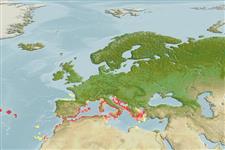Classification / Names
ชื่อสามัญ | ชื่อพ้อง | Catalog of Fishes(สกุล, ชนิด) | ITIS | CoL | WoRMS | Cloffa
>
Blenniiformes (Blennies) >
Tripterygiidae (Triplefin blennies) > Tripterygiinae
Etymology: Tripterygion: Greek, tres tria = three + Greek, pteron = wing, fin; diminutive (Ref. 45335); tartessicum: Named for the old Spanish culture (Tartessos, at least dating from 1000 BC), located on the south coast of the Iberian peninsula (in modern Andalusia, Spain), where the new species is partially distributed..
Environment: milieu / climate zone / depth range / distribution range
นิเวศวิทยา
เกี่ยวกับทะเล,น้ำเค็ม สัตว์น้ำหน้าดิน; ระดับความลึก 0 - 6 m (Ref. 58124), usually 0 - 3 m (Ref. 58124). Tropical
Mediterranean and Eastern Central Atlantic: along the southern coast of Spain, from Plage David (Morocco) to Tunisia.
ขนาด / น้ำหนัก / Age
Maturity: Lm ? range ? - ? cm
Max length : 7.7 cm TL เพศผู้/กระเทย; (Ref. 58124)
Short description
เครื่องมือที่ใช้ในการแยกชนิดสัตว์,สิ่งมีชีวิตออกจากกัน | สัณฐานวิทยา | ความยาวต่างๆ
เงี่ยงครีบหลัง (รวม) : 19 - 21; ก้านครีบอ่อนที่หาง (รวม) : 12 - 13; เงี่ยงครีบก้น: 2; ก้านครีบอ่อนที่ก้น: 22 - 24. This species has an elongated and compressed body, greatest height at base of anal fin, being about one-sixth total length. Entire body with ctenoid scales except base of pectoral fin and ventral abdominal region back to vent. Lateral line with an anterior section with 20 (19-22) pored scales, and a posterior section with 22 (21-24) notched scales, total of 42 (40-46). Upper, anterior, section commencing at upper angle of opercular opening, slightly curving up over the pectoral fin base and running parallel to the dorsal profile to a point below last 1-3 rays of second dorsal fin; canal running across exposed width of each scale. Lower,
posterior, section commencing below, and in front of last scale or two of upper section, running along the mid-line of tail to caudal fin base; each scale with shallow notch in free-edge tip (Ref. 58124).
Adults inhabit similar habitats to Tripterygion tripteronotus, shallow rocky shores to 6 m,
preferably between 0 and 3 m; in light-exposed and shady biotopes dominated by algal communities (e.g. Corallina elongata, Cladophora spp., Litophyllum spp., Enteromorpha spp.). Nests are usually situated in sciaphyl habitats dominated by
steep rocky zones, without arborescent algae (Ref. 58124). Eggs are hemispherical and covered with numerous sticky threads that anchor them in the algae on the nesting sites (Ref. 240). Larvae are planktonic which occur primarily in shallow, nearshore waters (Ref. 94114).
Life cycle and mating behavior
Maturities | การสืบพันธุ์ | Spawnings | Egg(s) | Fecundities | ตัวอ่อน
Carreras-Carbonell, J., M. Pascual and E. Macpherson, 2007. A review of the Tripterygion tripteronotus (Risso, 1810) complex, with a description of a new species from the Mediterranean Sea (Teleostei: Tripterygiidae). Scientia Marina 71(1):75-86. (Ref. 58124)
IUCN Red List Status (Ref. 130435)
Threat to humans
Harmless
Human uses
เครื่องมือ
Special reports
Download XML
แหล่งที่มาจากอินเตอร์เน็ต
Estimates based on models
Preferred temperature (Ref.
123201): 17.6 - 20.1, mean 18.9 °C (based on 213 cells).
Phylogenetic diversity index (Ref.
82804): PD
50 = 0.5625 [Uniqueness, from 0.5 = low to 2.0 = high].
Bayesian length-weight: a=0.00692 (0.00371 - 0.01290), b=3.10 (2.93 - 3.27), in cm total length, based on LWR estimates for this species & (Sub)family-body (Ref.
93245).
ระดับชั้นอาหาร (Ref.
69278): 3.4 ±0.4 se; based on size and trophs of closest relatives
ความสามารถในการกลับคืนสู่ปกติ (Ref.
120179): ความสูง, เวลาต่ำสุดที่จะทำให้ประชากรเพิ่มขึ้นเป็น 2 เท่าใช้เวลาน้อยกว่า 15 เดือน (Preliminary K or Fecundity.).
Fishing Vulnerability (Ref.
59153): Low vulnerability (10 of 100).
